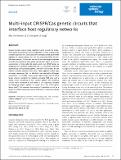Multi-input CRISPR/Cas genetic circuits that interface host regulatory networks
Author(s)
Nielsen, Alec Andrew; Voigt, Christopher A.
DownloadNielsen-2014-Multi-input CRISPR_C.pdf (567.0Kb)
PUBLISHER_CC
Publisher with Creative Commons License
Creative Commons Attribution
Terms of use
Metadata
Show full item recordAbstract
Genetic circuits require many regulatory parts in order to implement signal processing or execute algorithms in cells. A potentially scalable approach is to use dCas9, which employs small guide RNAs (sgRNAs) to repress genetic loci via the programmability of RNA:DNA base pairing. To this end, we use dCas9 and designed sgRNAs to build transcriptional logic gates and connect them to perform computation in living cells. We constructed a set of NOT gates by designing five synthetic Escherichia coli σ[subscript 70] promoters that are repressed by corresponding sgRNAs, and these interactions do not exhibit crosstalk between each other. These sgRNAs exhibit high on‐target repression (56‐ to 440‐fold) and negligible off‐target interactions (< 1.3‐fold). These gates were connected to build larger circuits, including the Boolean‐complete NOR gate and a 3‐gate circuit consisting of four layered sgRNAs. The synthetic circuits were connected to the native E. coli regulatory network by designing output sgRNAs to target an E. coli transcription factor (malT). This converts the output of a synthetic circuit to a switch in cellular phenotype (sugar utilization, chemotaxis, phage resistance).
Date issued
2014-11Department
Massachusetts Institute of Technology. Department of Biological Engineering; Massachusetts Institute of Technology. Synthetic Biology CenterJournal
Molecular Systems Biology
Publisher
Nature Publishing Group
Citation
Nielsen, Alec A.K., and Christopher A. Voigt. “Multi-Input CRISPR/Cas Genetic Circuits That Interface Host Regulatory Networks.” Molecular Systems Biology 10, no. 11 (November 1, 2014): 763–763.
Version: Final published version
ISSN
1744-4292